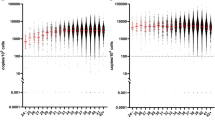Abstract
A homozygous antigen-loss variant for the TL antigen was isolated by immunoselectionin vitro. The variant expressed <0.01 the parental amount of TL antigen on its surface as measured by quantitative absorption. Neither theK nor theD end H-2k antigens were detectable on the surface of the variant, although parental amounts of Thy 1.2 and GCSA were expressed. Karyotypic analysis showed that the variant had one less chromosome than the parental line.
Similar content being viewed by others
References
Bjaring, B. and Klein, G.: Antigenic characterization of heterozygous mouse lymphomas after immunoselectionin vivo.J. Natl. Cancer Inst. 41: 1411–1429, 1968
Boyse, E.: Immunogenetics in the study of cell surfaces: Some implications for morphogenesis and cancer.In C. Anfinsen, M. Potter, A. Schechter (eds.):Current Research in Oncology, pp. 57–94, Academic Press, New York, 1973
Boyse, E., Old, L., and Stockert, E.: The TL (thymus leukemia) antigen: A review.In P. Grabar and P. Miescher (eds.):Immunopathology, IVth International Symposium, pp. 23–40, Schwabe, Basel, 1965
Boyse, E., Stockert, E., and Old, L.: Properties of four antigens specified by theTLa locus. Similarities and differences.In N. Rose and F. Milgrom (eds.):International Convocation on Immunology, pp. 353–357, Karger, Basel, 1969
Boyse, E., Stockert, E., Iritani, C., and Old, L.: Implications of TL phenotype changes in an H-2-loss variant of a transplanted H-2b/H-2a leukemia.Proc. Natl. Acad. Sci., USA 65: 933–938, 1970
Boyse, E., Old, L., and Stockert, E.: Antigen expression: The phenotype of lymphoid cells in relation to normal and abnormal differentiation.In E. Mihich (ed.):Drugs and Cell Regulation, pp. 145–158. Academic Press, New York, 1971
Brown, S.: Heterochromatin.Science 151: 417–425, 1966
Chasin, L.: The effect of ploidy on chemical mutagenesis in cultured Chinese hamster cells.J. Cell Physiol. 82: 299–308, 1973
Chasin, L.: Mutations affecting adenine phosphoribosyl transferase activity in Chinese hamster cells.Cell 2: 37–41, 1974
Fincham, J. and Sastry, G.: Controlling elements in maize.Ann. Rev. Genet. 8: 15–50, 1974
Hauschka, T., Hitt, S., Zumpft, M., Shows, T., and Boyse, E.: Immunoselective loss of parental H antigens by somatic reduction in an H-2a/H-2b hybrid mouse leukemia.Transplant. Proc. 7: 165–171, 1975
Horibata, K. and Harris, A.: Mouse myelomas and lymphomas in culture.Exp. Cell Res. 60: 61–77, 1970
Hyman, R.: Studies on surface antigen variants. Isolation of two complementary variants for Thy 1.2.J. Natl. Cancer Inst. 50: 415–422, 1973
Hyman, R. and Stallings, V.: Complementation patterns of Thy-1 variants and evidence that antigen loss variants “pre-exist” in the parental population.J. Natl. Cancer Inst. 52: 429–436, 1974
Klein, G.: Humoral and cell-mediated mechanisms for host defense in tumor immunity.In W. Burdette (ed.):Viruses Inducing Cancer, pp. 323–349, University of Utah Press, Salt Lake City, 1966
Klein, G., Friberg, S., and Harris, H.: Two kinds of antigen suppression in tumor cells revealed by cell fusion.J. Exp. Med. 135: 839–849, 1972
Lesley, J. and Hyman, R.: Antibody-induced changes in expression of the H-2 antigen.Eur. J. Immunol. 4: 732–739, 1974
Markert, C. and Ursprung, H.:Developmental Genetics, pp. 64–82, Prentice-Hall, Englewood Cliffs, N.J., 1971
Nathenson, S.: Biochemical properties of histocompatibility antigens.Ann. Rev. Genet. 4: 69–90, 1970
Ohno, S.: Genetic implication of karyological instability of malignant somatic cells.Physiol. Rev. 51: 496–526, 1971
Old, L., Stockert, E., Boyse, E., and Kim, J.: Antigenic modulation. Loss of TL antigen from cells exposed to TL antibody. Study of the phenomenonin vitro.J. Exp. Med. 127: 523–539, 1968
Pious, D., Hawley, P., and Forrest, G.: Isolation and characterization of HL-A variants in cultured human lymphoid cells.Proc. Natl. Acad. Sci. USA 70: 1397–1400, 1973
Ralph, P.: Retention of lymphocyte characteristics by myelomas and θ+-lymphomas: Sensitivity to cortisol and phytohemagglutinin.J. Immunol. 110: 1470–1475, 1973
Trowbridge, I. and Hyman, R.: Thy-1 variants of mouse lymphomas: Biochemical characterization of the genetic defect.Cell, in press, 1975
Vitetta, E., Uhr, J., and Boyse, E.: Association of a β2-microglobulin-like subunit with H-2 and TL alloantigens on murine thymocytes.J. Immunol. 114: 252–254, 1975
Wiener, F., Dalianis, T., and Klein, G.: Cytogenetic studies on H-2 alloantigenic loss variants selected from heterozygous tumors.Immunogenetics 2:63–72, 1975
Yu, A., and Cohen, E.: Studies on the effect of specific antisera on the metabolism of cellular antigens. I. Isolation by thymus-leukemia antigens.J. Immunol. 112: 1285–1295, 1974
Author information
Authors and Affiliations
Rights and permissions
About this article
Cite this article
Hyman, R., Stallings, V. Characterization of a TL−variant of a homozygous TL+ mouse lymphoma. Immunogenetics 3, 75–84 (1976). https://doi.org/10.1007/BF01576940
Received:
Issue Date:
DOI: https://doi.org/10.1007/BF01576940




